This study develops a stereoscopic vision system using a two-camera calibration method and BP neural networks combined with genetic algorithms to measure precision component dimensions. Images are processed using edge detection and Hough transform algorithms, and a machine vision-based inspection model is constructed. Bearing components are used as the research object to detect dimensions, edges, geometric parameters, and loose components under six angles. Maximum measurement deviation is 0.04 mm, and edge detection results are clear and concise. Geometric parameter deviations remain within [-5%, 5%], achieving high recognition accuracy. The detection model’s classification accuracy is 97.49%, with verification accuracy at 98.01%. Comprehensive false detection and leakage rates are 1.03% and 0.46%, respectively. The model demonstrates superior detection performance across various angles for bearing components.
With the rapid development of information technology such as artificial intelligence, internet of things, big data and so on, intelligent manufacturing has gradually become the direction of manufacturing upgrading. In the field of intelligent manufacturing, machine vision technology, as one of the important technical means, is being widely used [6,8,13]. Machine vision technology refers to the processing and analysis of images or videos through computers and related hardware systems, so that they have the visual ability of the human eye, thus achieving the recognition, detection, measurement, tracking and other functions of the object [26,9,23]. Machine vision technology can process images, videos and other types of data, the core of this technology is image processing algorithms and pattern recognition algorithms, which play an important role in the automated detection of precision components [11,1,24].
Machine vision technology can be used for automated inspection and quality control of precision components on production lines. For example, in the process of automobile manufacturing, the application of machine vision can detect whether the size of the components meets the standard, and whether the components and the whole vehicle are properly spliced together [7,17,29]. At the same time in the detection, machine vision can also collect and analyse the data to help enterprises timely find the problems on the production line, and make improvements. In intelligent manufacturing, machine vision technology features and application advantages can improve the quality and efficiency of precision components, achieve intelligent production, and play an important role in enhancing the core competitiveness of enterprises [4,27,22,16].
Literature [10] explores the many applications of machine vision and the role it plays in Industry 4.0 and presents various smart technologies in the form of diagrams and charts of machine vision for Industry 4.0. It is indicated that any step in Industry 4.0 and related digital industrial transformation, including manufacturing, supply chain, etc., reflects different innovative approaches. Literature [20] developed an image-based framework which uses pre-trained CNNs and ResNet-101 to detect defects, and confirmed the feasibility of the framework by launching a study on common surface defects in centre polishing. In addition, ResNet-101 is used to extract features and combined with SVM as a classifier to detect defective images, and the results show that the proposed framework effectively performs image classification with 100% detection accuracy. Literature [2] proposes a machine vision model which is capable of identifying the defects of a product and modifying it to obtain a perfect product, which meets the requirements of ensuring product quality in the context of Industry 4.0. Literature [12] analysed the application of machine vision systems in the automotive industry China in recent years and predicted the trend of the future development of this technology. The results of their analyses show that machine vision technology is more often used in quality-related tasks and has shown excellent results in the automotive manufacturing sector. Literature [28] shows that computer vision technologies have promoted the informatisation, digitisation and intelligence of industrial manufacturing systems, and based on the rapid development of CV technologies, a comprehensive review of the current status of the development of these technologies as well as their applications in manufacturing is presented. Literature [14] introduced the current development of machine vision technologies in terms of hardware, software and industrial inspection, indicated that the combination of multiple technologies can promote the performance and efficiency of inspection in various applications, and affirmed the development potential of machine vision systems in industry. Literature [5] presents the results of a study that investigated the effect of lighting technology on machine vision inspection techniques for automated assembly machines with highly reflective metal surfaces. Whereas the light reflection from the machine surface makes glare in the image a major difficulty, inspections were carried out using a high resolution high-speed camera under different lighting conditions with the aim of checking the effect of illumination on the inspection performance of flat specular reflections.
The article builds a binocular stereo vision system, measures the dimensions of precision components by using the method of dual camera calibration, and then uses BP neural network and genetic algorithm to calibrate the camera. The edge detection algorithm and Hough transform algorithm are used to process the images of precision components and identify them, so as to construct a precision component detection model based on machine vision. The model is applied to the detection of bearing components to detect and analyse the dimensions, edges, and geometric parameters of the bearing components and identify the loose bearing components. Finally, the false detection rate and leakage rate of this paper’s precision component detection model are tested under six angles to examine the adaptability of this paper’s model to the detection angle.
The binocular stereo vision system is shown in Figure 1, assuming that the
orthogonal unit matrices and translation vectors of the outer parameters
of the two cameras are
Eliminating the coordinates of point
In the formula,
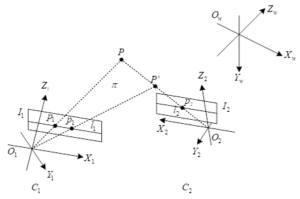
Let the chi-square coordinate of spatial point
Denote the vector on the right-hand side of Eq. (6) as
Assume vector
By the nature of antisymmetric matrix, i.e.
The right vector
In binocular vision system, if the chi-square coordinate of image
point
On the other hand, if any point
For the measurement of top surface, bottom surface and side surface,
the accuracy is required to be within 30
Through the above analysis, for large-size high-precision measurement, using a single camera is difficult to achieve, need to seek other solutions. How to make the camera resolution in a certain size, effectively improve the single-pixel accuracy is a problem that needs to be solved. It is considered that the camera field of view can be reduced, i.e., instead of using a single camera to capture the global image, two cameras are used to capture the local image separately, so that the distance value from the edge to the optical centre can be obtained. However, the global size measurement task cannot be accomplished by the information from the local images alone, so the positions of the two cameras are calibrated to obtain the distance value between the photocentres of the two cameras, and this value is added to the edge-to-centre distances of the two edges to achieve the global size measurement.
Camera perspective model
The camera perspective model is shown in Figure 2, with
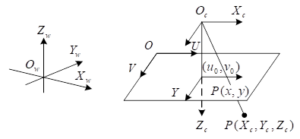
BP neural network design
The BP neural network model is shown in Figure 3. The network has 3
layers, its input layer has 4 neurons, corresponding to the input signal
is the coordinates of the spatial point in the world coordinate system
with constant 1: its hidden layer has 3 neurons. The output layer has 2
neurons. The output expected value vector is
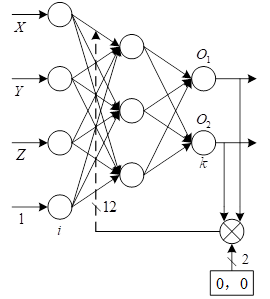
The input to the
The input to the
The excitation function
According to the camera mathematical model, the output expectation
vector of the neural network is
During neural network training, the weight matrix between the hidden
layer and the output layer remains unchanged, and the weights between
the input layer and the hidden layer:
Adaptive genetic algorithm
Genetic algorithm is an adaptive heuristic search mechanism that
includes three operations: replication, crossover and mutation [19]. In the experiment, the search
space for each element in an individual is (-50000. 50000), the size of
the population is
Evolutionary speed factor
In the longitudinal direction, the direction and degree of evolution
of an individual can be predicted by the evolutionary rate factor of the
individual. If a chromosome is denoted as
Then
Aggregation factor
In the horizontal direction, during the iteration process, if the
diversity among individuals decreases too fast, the algorithm may not
find the global optimal solution of the system. In order to describe the
diversity among individuals, the concept of aggregation degree is
introduced. Assuming that the centre position of all individuals in
generation
It is clear that
Changes in the grey level of pixel points in an image produce distinct edges at the boundaries where there is a large change in grey level, which is the basis for image segmentation. However, there is a substantial difference between edges and boundaries: boundaries are the boundaries between objects in a realistic scene, because the realistic scene is three-dimensional. But the captured image is two-dimensional, and the position of the grey scale change of the pixel points in the image is called the edge. The mapping from a three-dimensional realistic environment to a two-dimensional image leads to the loss of a lot of information, whether it is the effect of noise or lighting and other factors can have an important impact on the imaging, so these reasons that do exist and can not be completely eliminated make the lack of edge extraction algorithms of the image is still a bottleneck in the digital image technology.
Laplacian operator
The Laplacian operator is a second order differential operator [3]. The matrix operator for
convolution is:
Then the arithmetic formula is:
It can be seen that the second order derivatives at the boundaries are heteroscedastic, which exactly reflects the direction and strength of the image edges. This operator has no directionality and is very significant to abrupt changes in the grey scale of the image. Because the operator is a second-order operator so sensitive to image noise, so the requirements for image acquisition is higher and in the image preprocessing must first do a better smoothing.
Roberts operator
Roberts operator is two diagonally oriented differential operator
which calculates the gradient of the neighbouring pixels on the diagonal
[21]. The two diagonal
operators are as:
The grey scale difference between adjacent diagonal pixel points is:
Then:
Derivation of
Sobel operator
The Sobel operator is a process of comparing the magnitude of the
grey scale gradient, it is not a uniform first order differentiation of
the whole image, but a comparison of differentiation operations in both
directions [15]. The
differential convolution operator in the horizontal and vertical
directions is shown in:
As can be seen from these two operators, Sobel discriminately detects the neighbours above and below and to the left and right of a pixel point, and then compares these two gradient sizes and retains the larger one, which determines that this operator has a great advantage in extracting the edge direction, but the edge position will not be guaranteed to be accurate, so there will be a case of inaccuracy of the edge position.
Canny operator
Canny operator is an optimization operator, which has the characteristics of multi-stage filtering, enhancement and detection [25].Canny operator firstly uses Gaussian filter to smooth the image to remove noise, then Canny operator uses the difference of first-order derivatives of the image to calculate the gradient magnitude and direction of the grey scale, in the whole process Canny operator also undergoes a non-maximum value suppression process, after that Canny operator is used to calculate the gradient magnitude and direction of the grey scale, and then it is used to calculate the gradient direction. In the whole process the Canny operator also undergoes a non-maximum suppression process, after which the Canny operator finally sets two thresholds to connect the edges.
The Laplacian operator is a second-order operator that is sensitive to grey scale changes and accurate in positioning, but at the same time is overly sensitive to noise, so it tends to be more affected by noise.The Roberts operator is a more diagonal differential operator, with a high degree of positional accuracy for edges, but sensitive to noise. The Sobel operator compares the vertical and horizontal gradient directions; the edge directions are accurate, but the edge locations tend to be blurred.
Variable Scale Differential Operator (VSD)
The method of image differentiation can eliminate the effect of inconsistency, through the previous analysis of various edge operators can be seen, the essence of edge extraction is a process to achieve differentiation of grey-scale map, for a variety of classical edge extraction operators, are only detecting the image changes relatively drastic region, so there is a dimension can not be more accurate extraction of image edges.
Thus, in order to extract features that are sufficiently distinguishable from slowly changing signals, a variable-scale image differentiation is proposed to solve this problem, and the operator is shown in Figure 4 (with the Sobel operator as an example).
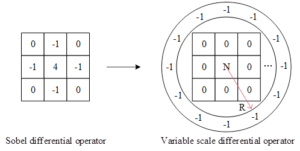
For the variable scale differential operator presented in this section, it can be seen that it is an operator that differentiates for each angle, and it is the diversity of angles that allows for a better extraction of the changes in the retarded signal.
Hough transform basic principle and implementation
Detecting a straight line using Hough transform is to transform a
straight line from the original space to the parameter space [18]. The equation of a straight
line is:
Through the Hough transform, the image space
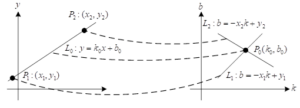
As can be seen from Figure 5, the
In the
A point
The polar coordinate system is micromanaged into a square grid, in
the right-angled coordinate system
Hough-based target localisation
In order to avoid misjudgement due to positional errors through the algorithm firstly the part is localised in the image so that the region of interest can be determined.
For the extracted edge of the measured part, there exists a straight line at the bottom edge, which is found by Hough transform, with the slope and intercept of the straight line, the position of the part in the image can be obtained by the equation of the straight line.
In this paper, we take the bearing assembly as an example to study in depth the application of the precision component inspection model based on machine vision constructed in the previous paper in the bearing assembly.
For the same bearing standard parts in the field for 8 measurements, the size measured by the inspection model and the actual inspection size of the workpiece are compared, the component size measurement results are shown in Table 1. From the measurement data in Table 1, the maximum deviation value is 0.04mm in 8 measurements, and the maximum deviation value at each position is within the 0.05mm range required for inspection in this paper. In the eight measurements carried out in six positions did not appear to exceed the model requirements, it can be seen that the component size measurement method in this paper has excellent results.
| Number | Position 1 | Position 2 | Position 3 | Position 4 | Position 5 | Position 6 |
| 1 | 80.11 | 80.46 | 35.71 | 82.43 | 80.05 | 39.46 |
| 2 | 80.17 | 80.42 | 35.72 | 82.46 | 80.01 | 39.43 |
| 3 | 80.13 | 80.48 | 35.73 | 82.45 | 80 | 39.44 |
| 4 | 80.12 | 80.49 | 35.76 | 82.48 | 80.04 | 39.41 |
| 5 | 80.18 | 80.42 | 35.76 | 82.44 | 80.05 | 39.42 |
| 6 | 80.19 | 80.42 | 35.69 | 82.47 | 79.99 | 39.45 |
| 7 | 80.11 | 80.48 | 35.72 | 82.48 | 80.06 | 39.44 |
| 8 | 80.17 | 80.46 | 35.69 | 82.41 | 80.04 | 39.48 |
| Standard component | 80.15 | 82.46 | 35.72 | 82.44 | 80.03 | 39.45 |
In order to further quantitatively evaluate the effect of detection, standard deviation, peak signal-to-noise ratio, information entropy, and average gradient are selected as evaluation indexes in this paper. Among them, the standard deviation indicates the degree of dispersion of the grey value of the image relative to the mean value, and the more dispersed the grey level indicates the more prominent the edge of the image. The peak signal-to-noise ratio indicates the error between the corresponding pixel points, and the larger its value indicates the smaller the distortion, and the bivariate map of the edge is used as a reference in the calculation. Information entropy indicates the degree of information clutter, and larger values indicate that the image contains more information. The average gradient indicates the rate of change of the edges in the image, and a larger value indicates a clearer image.
The objective evaluation of different edge detection operator methods and the Variable Scale Differential Operator (VSD) method proposed in this paper for the edge detection of virtual model and 3D model at each angle map, five working conditions of the bearing components are selected for analysis. The results of the objective evaluation of images are shown in Table 2.
As can be seen from Table 2, for images with different acquisition modes and different targets, except for condition three, the standard deviation and peak signal-to-noise ratio of the variable scale differential operator (VSD) method proposed in this paper are better than those of the above algorithms, which indicates that the edge details detected by the variable scale differential operator (VSD) method in this paper are more accurate. The information entropy of this paper’s Variable Scale Differential Operator (VSD) method under four working conditions (except for condition three) is 0.1151, 0.0406, 0.0685, 0.1065 (all the smallest among all edge algorithms), indicating that the detected edges reduce the influence of the noise, the information is more streamlined, and the image is clearer. Edge extraction experiments on the bearing component image, although for a small number of edge mutations and irregular edges at the effect is not ideal, but for the follow-up work does not affect the majority of the edges still achieve an effective connection, and this paper’s variable scale differential method in the standard deviation, peak signal-to-noise ratio, information entropy, average gradient objective evaluation indexes are more excellent performance. In this paper, the variable scale differential operator method can effectively connect the edges of the bearing components, laying the foundation for the subsequent identification of the geometric parameters of the bearing components.
| Method | Operating condition | Evaluation index | |||
| STD | SPNR | Entropy | Mean gradient | ||
| Roberts | 1 | 51093 | 6.175 | 0.9917 | 1.1846 |
| Sobel | 80153 | 3.672 | 1.8429 | 2.6238 | |
| Laplacian | 19905 | 9.348 | 0.5429 | 0.9741 | |
| Canny | 50667 | 12.694 | 0.2048 | 1.6849 | |
| VSD | 2074 | 20.592 | 0.1151 | 2.9234 | |
| Roberts | 2 | 37468 | 7.846 | 0.7428 | 0.4685 |
| Sobel | 62488 | 5.048 | 1.3486 | 0.7816 | |
| Laplacian | 49834 | 6.297 | 1.1485 | 0.8549 | |
| Canny | 894 | 25.744 | 0.0895 | 0.1126 | |
| VSD | 85 | 35.948 | 0.0406 | 0.0689 | |
| Roberts | 3 | 40168 | 7.485 | 0.8264 | 0.5348 |
| Sobel | 70384 | 4.952 | 1.4528 | 1.2643 | |
| Laplacian | 50786 | 6.644 | 1.0535 | 1.7924 | |
| Canny | 466 | 28.45 | 0.0388 | 0.3729 | |
| VSD | 642 | 24.69 | 0.0795 | 0.8842 | |
| Roberts | 4 | 19584 | 0.523 | 1.7854 | 2.5846 |
| Sobel | 20749 | 0.384 | 2.8458 | 11.5668 | |
| Laplacian | 13665 | 2.341 | 2.6344 | 0.3874 | |
| Canny | 1285 | 20.173 | 0.0726 | 0.4682 | |
| VSD | 624 | 27.446 | 0.0685 | 0.5213 | |
| Roberts | 5 | 20485 | 0.426 | 2.0755 | 3.4825 |
| Sobel | 20146 | 0.448 | 2.8429 | 6.4872 | |
| Laplacian | 13482 | 2.647 | 2.4058 | 12.1784 | |
| Canny | 2644 | 18.488 | 0.1547 | 3.5958 | |
| VSD | 2304 | 20.648 | 0.1065 | 1.9485 | |
The geometric parameters of the bearing components are identified, and the development environment used for the experiments is as follows: the CPU is an Intel(R) Xeon(R) Platinum 8163 2.50GHz 96-core processor with 224GB of RAM, and an NVIDIA GeForce RTX 2080Ti graphics card with 12GB of video memory. The software development platform is Win10 64-bit operating system, with Pycharm as the development tool, mainly using OpenCV-Python to process edge images, using Numpy as the matrix processing of scientific computing, and Pytorch as the framework for experiments.
Referring to the products of a bearing manufacturer, the inner ring, outer ring, rolling element and cage of the bearing are taken as the research objects, and 4800 cross-section images of the bearing components are generated as the dataset by taking the original control parameters as the basis, floating within the error range of 30%, and increasing the random amount. 10% of the data, i.e., 480 edges, are randomly selected as the validation set, and the remaining 90% of the edges, i.e., 4320 edges, are used as the training set.
Randomly extract 2400 edge images, the detection model based on BP
neural network and genetic algorithm and the fully connected neural
network model of this paper are used to identify the geometric
parameters of the images and calculate the relative error, the error
analysis of the identification of geometric parameters of the bearing
assembly cross-section is shown in Figure 6, in which Figure 6(a) is the
result of the recognition of the fully connected neural network, and
Figure 6(b) is the result of the recognition of this
paper’s method, H, t
As can be seen from Figure 6, the distribution range of geometric parameter
recognition results of the fully connected neural network is larger, and
almost all geometric parameter recognition results are in the interval
of [-90%,80%]. The distribution range of the results of the BP neural
network+genetic algorithm is smaller, and the geometric parameters
basically fall within the interval of
From Figure 7, it can be seen that for the fully connected network, 68.90% of the prediction errors for gap m are within 20%, and 75.55% of the prediction errors for the other 8 key control parameters are within 20%. For BP neural network + genetic algorithm, the prediction errors of 9 key control parameters are within 5%. In terms of analysis efficiency, the performance of deep convolutional neural network in both training and prediction is much better than that of fully connected neural network, so the deep convolutional neural network is a model more in line with this application scenario, and this paper will use the deep convolutional neural network for the subsequent research.
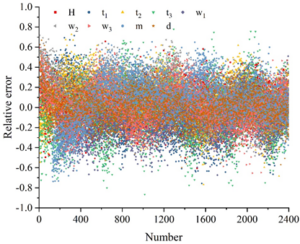
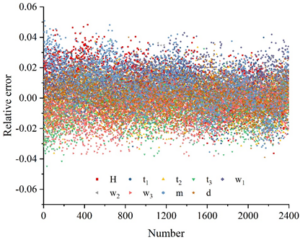
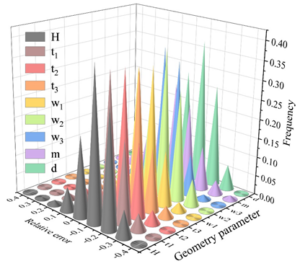
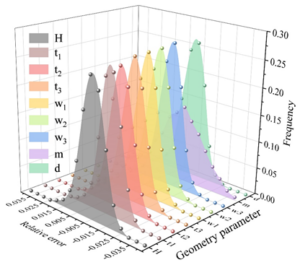
The bearing assembly images used in the bearing assembly loosening recognition experiments were collected from the bearing manufacturers in the previous section, of which 14,000 sheets of normal assemblies and 4,000 sheets of each of the loose assemblies were used. The experiments in this section use 20,000 normal bearing assemblies and 4,000 loose bearing assemblies as the training set, and use the remaining 8,000 normal bearing assemblies and 4,000 loose bearing assemblies to match into 4,000 pairs of images of the same category and 4,000 pairs of images of different categories, in order to test the recognition performance of the precision intergroup detection model based on machine vision in this paper.
In order to verify the advantages of the method in this paper, the experiments in this section are compared with the existing methods (CIPSO, ALOK, DPM, YOLOv4, Faster R-CNN, HOG+KNN, PHOG+SVM, Harr+AdaBoost). In order to fairly compare the performance of the loss function, all methods use MSRNN network as the feature extraction network and use the same training method and training parameters. The experimental results are evaluated using two metrics: classification recognition accuracy and verification recognition accuracy, and the detailed experimental results are shown in Figure 10.
According to the experimental results, it can be seen that the classification recognition accuracy and verification recognition accuracy of the machine vision-based precision component detection model proposed in this paper are the maximum among all detection methods, and the method in this paper finally achieves the optimal recognition performance, with the classification recognition accuracy of bearing component looseness reaching 97.49% and the verification recognition accuracy reaching 98.01%, which fully proves the effectiveness of the method in this paper. It can also be seen from the experimental results that a higher recognition accuracy is achieved using verification recognition than classification recognition.
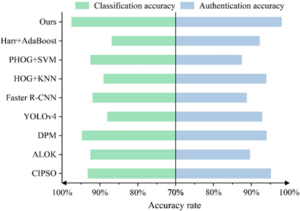
In order to verify the effectiveness of this paper’s method for
detecting the angle of the bearing assembly, this paper’s method is used
to detect the images of the bearing assembly at different angles. The
detection results are shown in Table 3. The experimental results in
Table 3
show that this paper’s model has the lowest false detection rate and
leakage rate of the bearing assembly at 90
| Angle | False detection rate/% | Undetected rate/% | Time/ms |
|
30 |
0.89 | 0.31 | 179 |
|
45 |
0.92 | 0.34 | 180 |
|
60 |
0.85 | 0.28 | 174 |
|
90 |
0.98 | 0.42 | 186 |
|
180 |
1.06 | 0.69 | 192 |
|
270 |
1.45 | 0.73 | 195 |
| Comprehensive condition | 1.03 | 0.46 | 184 |
This paper establishes a stereo vision system, uses BP neural network and heritage algorithm to calibrate the camera, and designs the detection model image processing and recognition algorithm to construct a precision component detection model based on machine vision. Taking the bearing component as an example, the component dimensions, edges, and geometric parameters are detected, and the recognition effect of components under suspicious components and different angles is tested.
In 8 measurements of the same bearing standard component, the maximum
deviation value at each position is not more than 0.05 mm. The
information entropy of the processing results of the edge detection
method in this paper is the smallest among all edge algorithms in most
cases, and the detected edge information is more streamlined and the
image is clearer. The geometric parameters of the bearing components
detected by the detection model in this paper basically fall within the
1970-2025 CP (Manitoba, Canada) unless otherwise stated.